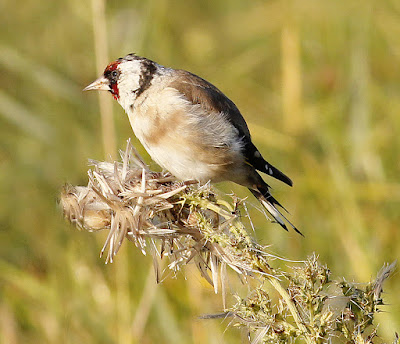It was my turn to top up the Oakenclough feeding station today. The continued rain and wind suggests the next ringing session may be later rather than sooner, but we live in hope.
Nearby St Michael’s village has suffered a bad episode of flooding via the River Brock but the Fylde Coast as a whole has escaped relatively unscathed from the severe floods that devastated parts of Lancashire and Cumbria just to the north of here. The wholesale destruction has led to the loss of life, homes and livelihoods. St Michael’s and the A586 was still blocked by floodwater this morning so I took a detour through Cockerham, past the flooded fields of Winmarleigh Moss and headed to the north of Garstang and a drive into the hills.
At Cockerham the still very flighty Linnets look to have increased to more than 140 birds feeding in the area of a weedy set-aside. They flew around constantly before they settled down to feed or sit along a barbed wire fence, only to erupt into flight again within just a few seconds.
There was a Kestrel about which probably accounts for the Linnets’ wariness. Although mainly a specialist in taking small mammals a Kestrel is also an opportunist hunter not averse to snatching small birds should they make themselves available. There was a male Stonechat feeding in the same field which sat up on weedy stems a few times in between bouts of feeding before I lost sight of it.
Stonechat
Predictably there was a Buzzard along the fences at Braides Farm. There must be a wealth of invertebrate food here as there are always one and very often two Buzzards present.
Just past the village of Oakenclough I came upon a flock of mixed finches in roadside alder trees, approximately 40 Goldfinch, 15 Chaffinch and 12 Siskin. The flock was considerably more birds than I saw 500 yards away at our feeding station, a somewhat open spot which has taken a real battering during wet and windy November/December. I topped up the feeding station, counted a single Mistle Thrush, half-a-dozen Chaffinch, a few Goldfinch and Blackbirds and then crossed my fingers before heading down to the coast again.
Back at Cockerham a flight of 8 Whooper Swans flew inland in the direction of Pilling Moss where there have been recent counts of up to 200 birds on the flooded stubble of Eagland Hill.
Meanwhile at Fluke Hall yet another flooded field held over 250 passerines in flocks of both single and mixed species. All were very flighty due to the constant passage of nearby people and vehicles, not least the number of dog walkers who encouraged their animals to both run wild and also defecate on private land where crops will be grown in spring.
The birds flew constantly between the sea wall, the nearby hedgerow and the field itself but after a while I estimated the birds as 135 Twite, 55 Goldfinch, 18 Skylark, 15 Tree Sparrow, 12 Linnet, 12 Meadow Pipit, 10 Pied Wagtail and 10 Chaffinch.
There’s more birding and photos soon from Another Bird Blog. With luck and fair weather there may even be a spot of ringing to report. Stay tuned.
Linking today to I'd Rather Be Birding, Eileen's Saturday and Run-A-Round Ranch.
Linking today to I'd Rather Be Birding, Eileen's Saturday and Run-A-Round Ranch.
































































.jpg)












